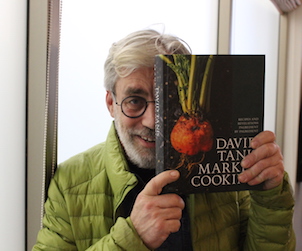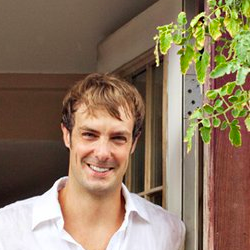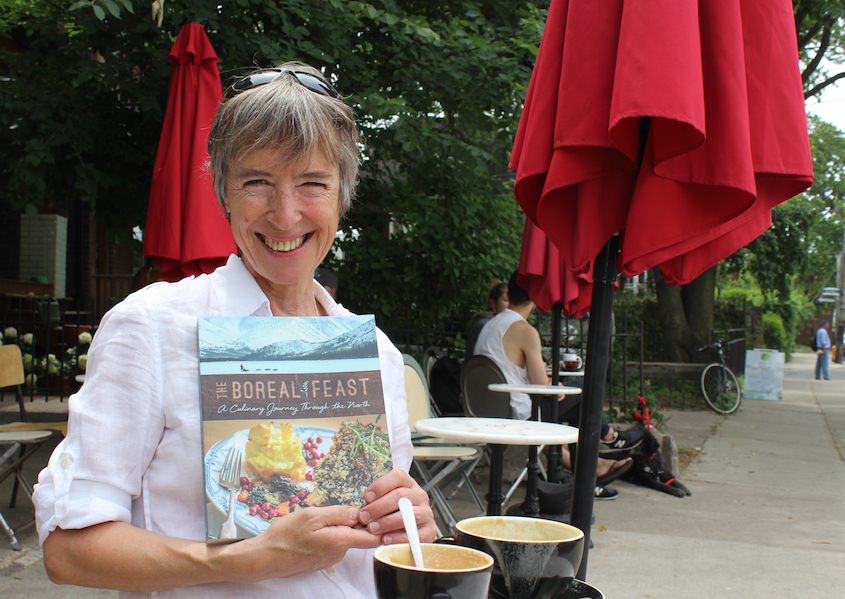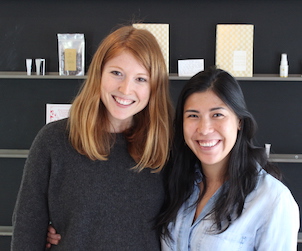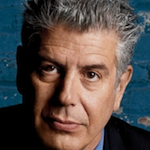Malcolm Jolley meets the author of this year’s celebrated Market Cooking cookbook.
One Sunday morning, one dozen and a half years ago, my wife pointed my attention to an article she’d just read in the New York Times Style Magazine about, what the reporter Ken Gross called “a new global dining phenomenon.” He meant secret dining clubs, that offered restaurant-like meals in private homes. Gross reported three clubs: one in Brooklyn and one in Berlin, but it was the one in Paris that really caught my attention:
David Tanis, who operates Aux Chiens Lunatiques (“At the Crazy Dogs’ Place”) in a 17th-century apartment that once belonged to David Sedaris, an occasional guest of the club, was trained by Alice Waters. For six months of the year, Tanis, 51, is the head chef at Chez Panisse in Berkeley, Calif., and the rest of the time he lives in the shadow of the Panthéon. “We came to live in Paris after 9/11,” he explains. “To live here and shop in the markets and cook for people who appreciate food is a very sweet way to live.”
Gross also reported in the his account, that the chef, David Tanis, was about to publish his first cookbook, A Platter of Figs, That book was very well received and precipitated a pivot in Tanis’ life away from Paris and Chez Panisse to New York City and a career as a food writer. His New York Times column, City Kitchen, appears there every week and features his seasonal, locavore, ingredient-based, straight forward style of cooking. His latest cookbook, Market Cooking: Recipes and Revelations Ingredient by Ingredient moves Tanis’ style forward, often showing subtly innovative approaches to familiar foods, like a lasagne made with rapini, a tomato salad that’s the stuffing for a sandwich, or turnips pan-roasted in butter to make a kind of confit. (One of my favourite things about Market Cooking is, by the way, that it has its own, chapter on turnips – though my wife seems relieved that it’s a short one.) There is also a signature Provençal soup recipe of his that uses not much more than water a clove of garlic and an egg.
Market Cooking is a beautiful book, set on heavy stock and each recipe is accompanied by vibrant, natural colour photographs by Evan Sung. The recipes are often presented in the style of Elizabeth David without a list of ingredients or numbered instructions, since many have only a few ingredients, and Tanis gets his reader to read through his description: who or where the dish comes from, how to do it just right, what to enjoy while cooking and eating it. It’s a very charming book, indeed, and has quickly become a regular on our kitchen counter stand.
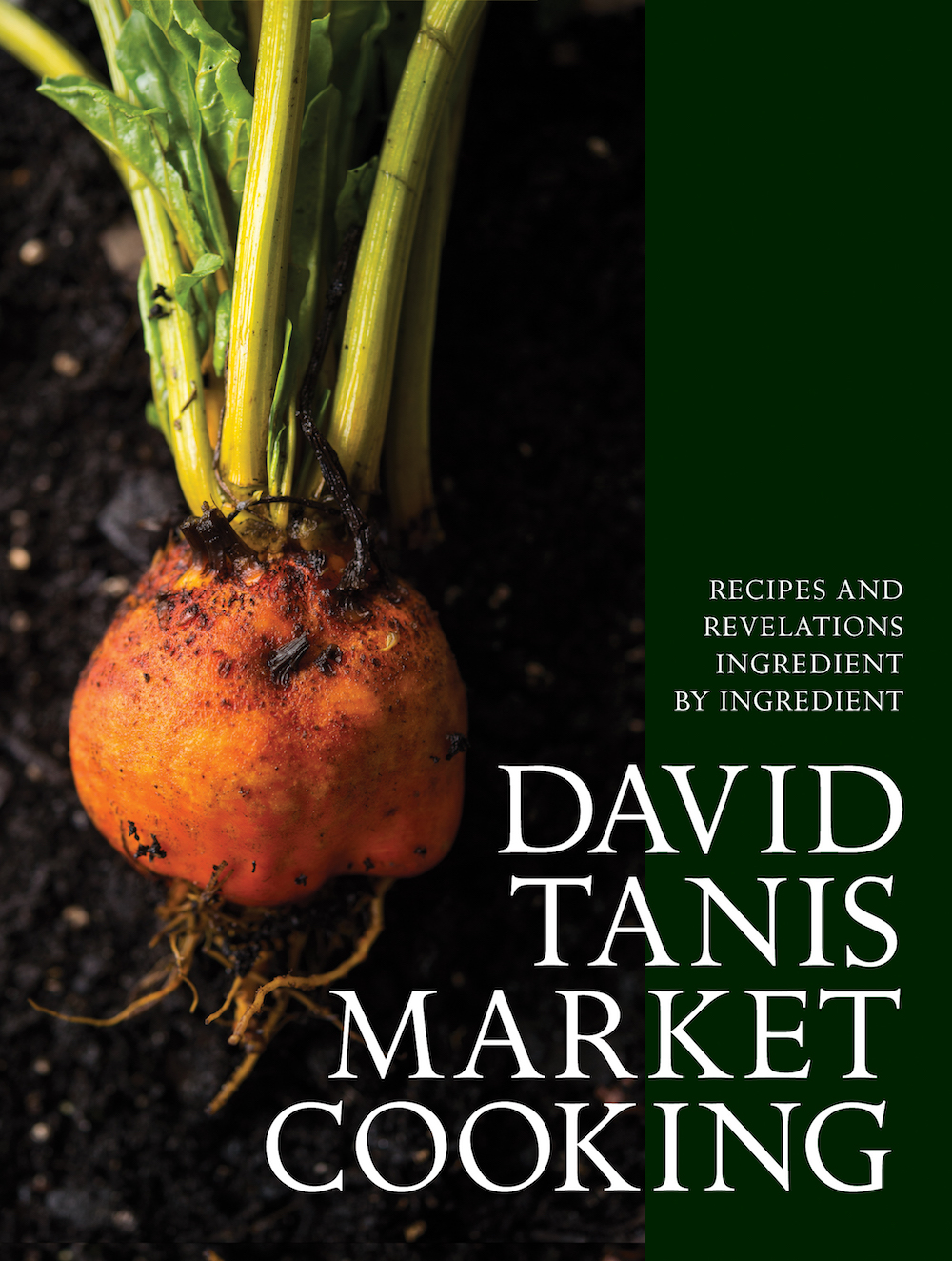
David Tanis was in Toronto recently to promote Market Cooking. When the book came out this fall, I contacted his Canadian publicist right away and asked for interview with the cook and saloniste I had read about so many years before. My slot was in the afternoon, after he’d been running around town being interviewed and making appearances, and before he was set to give a talk at the Reference Library. I suggested we meet near the library and his hotel at the bar at Brothers Restaurant, since the proprietors run an establishment very much in the tradition of Tanis’ ingredient-based cooking, and there would be an option for a glass of good wine, or a strong coffee, depending on what was required. This turned out to be a good move, since Brothers was indeed pleased to have the legendary chef in their house and, over the time we there, a veritable who’s who of Toronto’s new generation of fine dining and wine trade professionals came in and out, and stopped by to say hello. Because the restaurant was still busy, there was too much noise to record our interview and I took notes. Here’s what I remember of our conversation.
Over a glass of Poulsard from the Jura (him) and a Cortese from the Tortenesi hills neighbouring Gavi (me), I asked David Tanis how he got started as a chef. He smiled and explained that “in the 1970’s in California dropping out of college to pursue your dreams was a normal thing to do”. Then, he became more specific: it was at a small Central California school, near the border with Nevada, called Deep Springs College, that Tanis realized he was spending more time in the kitchen, hanging out with the European chefs, than he did at the library. He learned to cook by watching the professionals and reading what he could find, building up experience in what he called the Kitchen Essentials, which is also the name of a section of chapters in Market Cooking. Eventually he did leave school and found employment in the restaurant business and ending up in Berkeley at Chez Panisse. Despite that pedigree, or maybe because of it, David Tanis told me, “I still don’t consider myself a chefy chef.”
I asked David Tanis about the book, what was he trying to do when first sat down to write it? He answered that he knew he wanted it to be about vegetables, and then it took shape as he imagined the different chapters. I had a pang of panic. I had read through the book, but I hadn’t really got deep into Market Cooking and my knowledge of it was on the order of “journalist-superficial”. Was it a vegetarian cookbook, and did I fail to notice it, I asked. He took my ignorance in cheerful stride and replied that no, there is meat in the book, but its mostly part of a recipe focused on a vegetable, herb or spice. So, Chicken with 40 Cloves of Garlic is in the garlic chapter, and there is no chicken chapter.
We talked about the chapters: I think it’s really cool that alliums get their own section, with individual chapters for garlic, onions, leeks, shallots, and scallions. David Tanis explained that while he didn’t necessarily want the book to be about “apples to zucchini’s”, his intention was to give his reader a broad range of ingredients. Indeed, the book is organized around a few recipes for a lot of ingredients. Another section of the book, apart the main one called Mad For Vegetables, is The Art of Seasoning, which covers he way of using salt, some spices and a whole chapter on chiles – the hot pepper kind.
Was Market Cooking also organized by season, I asked David Tanis, looking at the progression of vegetable chapters in the table of contents. Sort of, he replied. The chapters, he explained are actually meant to progress from lighter ingredinets and dishes to heavier ones, but that progression will more or less follow what’s at the farmers’ markets.
As we finished our glasses of wine, David Tanis got a little philosophical at my prompting. What was he trying to get people to do with his cookbooks, and his newspaper columns, I wanted to know. He said he really just wanted people to cook more at home. He explained that was why his recipes don’t “get too hung up on technique”, that he hoped his readers would find enjoyment the process of cooking with the best ingredients they could find. He said, “My recipes do require a little bit of work, but I hope it’s very enjoyable work.”
David Tanis keeps a website at davidtanis.com.

